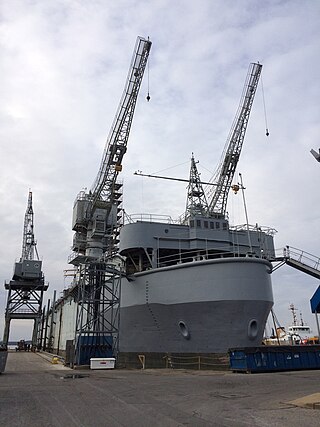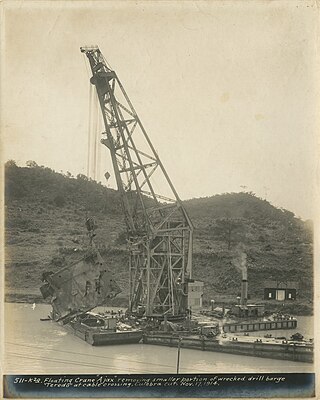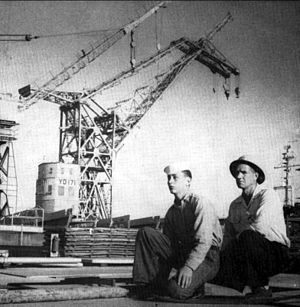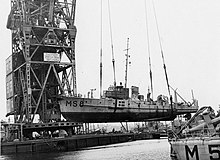
A crane is a machine used to move materials both vertically and horizontally, utilizing a system of a boom, hoist, wire ropes or chains, and sheaves for lifting and relocating heavy objects within the swing of its boom. The device uses one or more simple machines, such as the lever and pulley, to create mechanical advantage to do its work. Cranes are commonly employed in transportation for the loading and unloading of freight, in construction for the movement of materials, and in manufacturing for the assembling of heavy equipment.

The Hunters Point Naval Shipyard was a United States Navy shipyard in San Francisco, California, located on 638 acres (258 ha) of waterfront at Hunters Point in the southeast corner of the city.

The Long Beach Naval Shipyard, which closed in 1997, was located on Terminal Island between the city of Long Beach and the San Pedro district of Los Angeles, approximately 23 miles south of the Los Angeles International Airport. The primary role of NSY Long Beach at the time of its closure was overhaul and maintenance of conventionally-powered US Navy surface ships, but it also had served as the homeport for several auxiliary ships during its operating history.

USS Oak Ridge (ARD-19/ARDM-1) was originally a United States Navy Auxiliary floating drydock suitable for dry docking destroyers, submarines and landing craft, built by the Pacific Bridge Company. In the early 1960s she was upgraded to support Los Angeles-class submarines, and re-classified as ARDM-1-class. A stern door and enclosed bow design allows for open ocean transits. The dock is non-propelled and therefore must be taken under tow to operational areas of the fleet. A steering mechanism with twin rudders is installed to facilitate this operation. Sufficient electrical power was provided by four diesel-driven generator sets to maintain all normal and operational requirements. Living, berthing, and mess facilities are provided for the dock's complement of 5 officers, 10 CPO's and a crew of 186.

USS Enoree (AO-69) was a Chiwawa-class oiler constructed for the United States Navy during World War II. She was the only U.S. Navy ship named for the Enoree River in South Carolina.

A heavy-lift ship is a vessel designed to move very large loads that cannot be handled by normal ships. They are of two types:

Severnaya Verf is a major shipyard on Gutuevsky Island in Saint Petersburg, Russia, producing naval and civilian ships. It was founded as a branch of the Putilov Plant in the late 1800s. Under the Soviets, the shipyard was generally known as Shipyard No. 190 and reverted to its former name in 1989.

USS Papago (ATF-160) was an Abnaki-class fleet ocean tug built for the United States Navy during World War II, and named for the American Indian tribe of the Piman family that formerly lived south and southeast of the Gila River in Arizona and the Mexican state of Sonora.

SM U-10 or U-X was the lead boat of the U-10 class of submarines for the Austro-Hungarian Navy during World War I. She was originally a German Type UB I submarine commissioned into the German Imperial Navy as SM UB-1.

Lützow was a heavy cruiser of Nazi Germany's Kriegsmarine, the fifth and final member of the Admiral Hipper class, but was never completed. The ship was laid down in August 1937 and launched in July 1939, after which the Soviet Union requested to purchase the ship. The Kriegsmarine agreed to the sale in February 1940, and the transfer was completed on 15 April. The vessel was still incomplete when sold to the Soviet Union, with only half of her main battery of eight 20.3 cm (8 in) guns installed and much of the superstructure missing.

The Beardmore Crane was a giant cantilever crane at the William Beardmore and Company yard.

Ajax is a floating crane built to move and install the canal locks and other large parts of the Panama Canal. Ajax also helped in ship repairs and clearing the canal as needed. Ajax and her identical sister crane, the Hercules, were the largest floating cranes at time of completion, able to install the massive Panama Canal locks. Ajax could lift a maximum of 250 tons to a height of 21 feet (6.40 m), with a close reach. At Ajax's far reach she could lift a maximum of 100 tons. Ajax and Hercules were built by Deutsche Maschinenbau AG (1910-1977) . After the Ajax and Hercules, Deutsche Maschinenbau AG later made the Langer Heinrich, or Long Henry in 1915, in use for 100 years.

Langer Heinrich, or in English Long Henry, is a floating crane commissioned in 1915 for the Wilhelmshaven Imperial Shipyard in Wilhelmshaven, Germany and has been located in Genoa, Italy since 1997. At the time of completion she was the largest floating crane in the world, passing up the Ajax crane barge completed in 1914.

An auxiliary floating drydock is a type of US Navy auxiliary floating dry dock. Floating dry docks are able to submerge underwater and to be placed under a ship in need of repair below the water line. Water is then pumped out of the floating dry dock, raising the ship out of the water. The ship becomes blocked on the deck of the floating dry dock for repair. Most floating dry docks have no engine and are towed by tugboats to their destinations. Floating dry docks come in different sizes to accommodate varying ship sizes, while large floating dry docks come in sections and can be combined to increase their size and lift power. Ballast pontoon tanks are flooded with water to submerge or pumped dry to raise the ship.

YFD-2 was an auxiliary floating drydock built for the United States Navy in 1901. The first parts were laid down in early 1901 at Maryland Steel Co. of Sparrows Point, Maryland. YFD-2 was the first of its kind, steel movable auxiliary floating drydock, used to raise large ships out the water for repair below the ship's waterline. YFD-2 had a 18,000 tons lifting capacity.

ABSD-3 is an advanced base sectional dock, constructed of nine advance base dock (ABD) sections for the US Navy as an auxiliary floating drydock for World War II. ABSD-3 was delivered to the US Navy in April 1944, and was commissioned on 27 October 1944. Advance Base Sectional Dock-3 was constructed in sections during 1942 and 1943.

USS ABSD-5, later redesignated as AFDB-5, was a nine-section, non-self-propelled, large auxiliary floating drydock of the US Navy. Advance Base Sectional Dock-5 was constructed in sections during 1943 and 1944 by the Chicago Bridge & Iron Company in Morgan City, Louisiana for World War II. With all nine sections joined, she was 825 feet long, 28 feet tall, and with an inside clear width of 133 feet 7 inches. ABSD-5 had two traveling 15-ton capacity crane with an 85-foot radius and two or more support barges. The two side walls were folded down under tow to reduce wind resistance and lower the center of gravity. ABSD-5 had 6 capstans for pulling, each rated at 24,000 lbf (110,000 N) at 30 ft/min (0.15 m/s), 4 of the capstans were reversible. There were also 4 ballast compartments in each section.
Pollock-Stockton Shipbuilding Company was established in 1942 to build ships needed for World War II. As part of the Emergency Shipbuilding Program the US Navy provided some of the capital to start Pollock-Stockton Shipbuilding at Stockton, California. The shipyard was located at San Joaquin River and Stockton Channel, near Louis Park. After the war the shipyard closed down in February 1946.

The Arrol Gantry was a large steel structure built by Sir William Arrol & Co. at the Harland and Wolff shipyard in Belfast, Northern Ireland. It was built to act as overhead cranes for the building of the three Olympic-class liners.

YSD-11 Class Seaplane Wrecking Derrick is a class of US Navy derrick crane ship. While listed to service seaplanes the crane was able to lift small boats and large engines also. Hull classification symbol YSD is for Yard Seaplane Dirrick, Yard as in ship repair yard. YSD-11s were used to remove broken seaplanes from the water for repair or regular maintenance. The US had 2,661 Consolidated PBY Catalina built for the war, Canada built 620. Other seaplanes built in mass production were the 1,366 Martin PBM Mariner, 749 Short Sunderland and 345 Grumman G-21 Goose. The YSD-11 Class Derrick was built to support naval operations during World War II, having a displacement of 220 tons no load and 270 tons loaded. The YSD-11 Class had a length of 104 feet; a beam of 31 feet and 2 inches; a draft of 4 feet. They had a top speed 10 knots, built with a steel hull. The ship had one American Hoist & Derrick model 685 rotating crane. The crane had a boom of 54 feet with a lifting capacity of 10 tons. The crane was powered by a 6-cylinder Cummins Diesel engine. The ship housed a crew of one Officer and 15 Enlisted men. The ships had a diving gear locker for the crew salvage work. For service power, the ship had two generators: one 30 kW Diesel engine to electric generator and one 20 kW Diesel Generator. Ship power was from two Superior model MRDB-8 200 HP Diesel engines with two propellers, 640shp. The YSD-11 Class Derricks were built by a number of United States shipyards, including Moore Equipment Company, Puget Sound Navy Yard, Charleston Navy Yard, Mare Island Naval Shipyard, Soule Steel Company, Pearl Harbor Navy Yard and Boston Navy Yard.






















